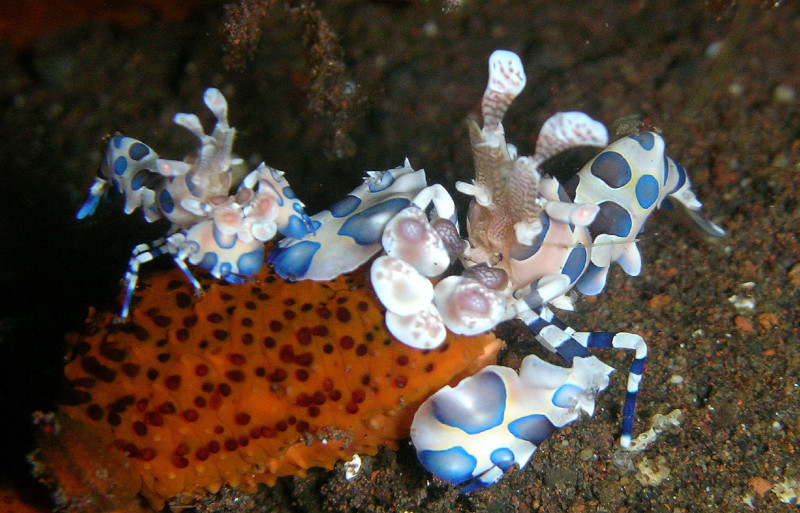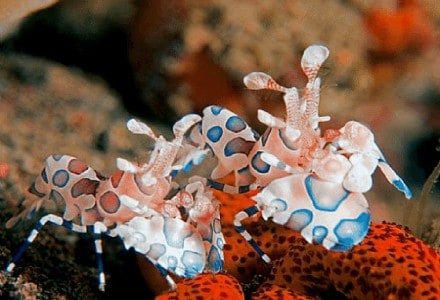
Harlequin Shrimp Facts
- Fascinatingly, the awesome Harlequin Shrimp remains a creature that not even the scientists can agree about. That’s because only some experts divide it into two distinct species. The majority, nevertheless, do consider it as only one species.
- This debate occurs due to an unusual fact, though. That’s the fact that specimens from its two distinct ranges have different color patterns. Other than that small difference, however, both groups remain physically indistinguishable.
- The noted French zoologist, Pierre Andre Latreille holds the distinction as the first researcher to officially recognize the creature. This he did in 1819. Whether it’s one species or two, scientists place it or them in the genus Hymenocera.
- The remarkable animal further evolved as extraordinarily sensitive to external stimuli. Any changes in temperature, water chemistry and salinity can therefore be detrimental to its health. Even high nitrate or copper levels can negatively affect it.
- As a result, the Harlequin Shrimp now faces an increased risk of extinction. Though several threats exist, the greatest peril comes from the effects of climate change. For the moment, though, the IUCN does not yet have a listing for this remarkable creature.
Related Articles
Pistol Shrimp Yeti Crab American Lobster
Harlequin Shrimp Physical Description
Quite noticeably, the gorgeous Harlequin Shrimp most commonly presents a bright color pattern. This pattern of colors, furthermore, usually consists of a background of either cream color or an off-white. Some small, widely scattered spots also appear.
These small spots cause the large debate, however. In fact, these serve as the source of debate among scientists. That’s because, individuals in one region display red spots. Meanwhile, those inhabiting the other region presents purple spots. Thus the confusion.
Both groups appear exactly the same otherwise, in terms of overall physical appearance. More specifically, a typical adult individual attains a length of about 2 in (5 cm). It does, however, like many related species, display a small degree of the trait of sexual dimorphism.
In the particular case of the Harlequin Shrimp, the characteristic manifests itself in terms of sheer physical size. In point of fact, males of this remarkable animal reach greater lengths than females. The difference, though, remains extremely minor.
- Kingdom: Animalia
- Phylum: Arthropoda
- Class: Malacostraca
- Order: Decapoda
- Family: Hymenoceridae
- Genus: Hymenocera
- Species: H. picta
Harlequin Shrimp Distribution, Habitat, and Ecology
The awesome Harlequin Shrimp, whether it be one species or two, lives in two widely separated areas. These two regions remain extremely similar in terms of environment, however. Its habitat zones consist of the tropical portions of the Pacific and Indian Oceans.
The majority of individuals, however, live in one very specific region of the globe. To be more specific, the greatest concentration of numbers appear in the region around Hawaii. It’s currently unknown if this is a relatively new development, or a long-term pattern.
In all regions the animal appears in, though, it prefers a specific habitat type. This specific preference includes coral reefs. Even in this, though, it remains choosy. Most live below the intertidal zone. It also prefers a highly specific water temperature range.
It further feeds almost solely on only type of prey. That prey consists of various types of starfish. But, on rare occasions, it will consume sea urchins as well. The animal first turns the hapless victim onto its back, and then proceeds to feed on its feet and other soft tissues.
The Harlequin Shrimp itself, meanwhile, has few natural predators known to science. This fact occurs partly because the arthropod sometimes absorbs toxins from its prey. This therefore makes its own flesh distasteful, and sometimes deadly, to potential predators.
Species Sharing Its Range
Giant Trevally Sea Spider Blue Shark
Check out our other articles on 4 Genuinely Gorgeous Grasshoppers, Adelie Penguin, Lagoa do Fogo, Turbinicarpus alonsoi, Tree Kangaroo, Brazilian Wandering Spider, Green Anaconda

